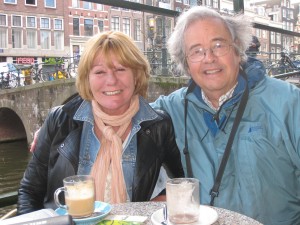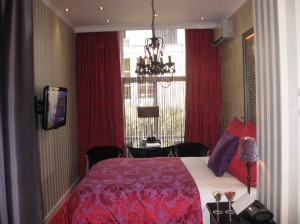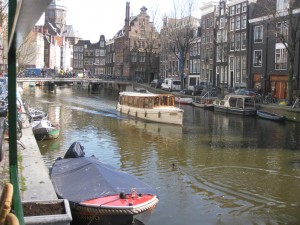Amsterdam – a city borne up by tolerance and time

One of Amsterdam’s best-known guides, Cecilia Theobaldi here with the author, who knows the city in detail, including its widely publicized and controversial Red Light District.
Special to the Spectator, Hamilton, Ontario June 23, 2012
Early one afternoon in Amsterdam, the air calm, we left the Toren, our hotel on Keizergracht — an inn blending modernity with elegance — to stroll beside the nearby canal. Suddenly we noticed something: no horns honked, no tires squealed. The only sounds were footsteps of pedestrians walking by the canal.

The Toren, one of the city’s widely respected small hotels, is family owned with the elegance of an historic inn yet with contemporary style.
That makes Amsterdam memorable, a quiet born of many canals, about 100 kilometres in all, and people, mostly walking or cycling. It’s a courteous city. It makes us recall a pleasure of the Toren hotel, the courtesy of its staff. In a conversation with Eric Toren, who with his wife Petra owns the inn, I mentioned their fine manners. He replied with a smile: “We can teach people to be efficient, but as for courtesy, they bring it to us. We get a very high rating for staff courtesy.”
As the world knows, Amsterdam is a banquet of cultural pleasure. Consider two indicators: it has more than 50 museums and offers 40,000 cultural performances and events a year. This, in a city of 750,000. Its history as a cultural capital is as remarkable as ironic. Much of its early social view, was formed by a stern version of Protestantism, given voice in the 1500s by the gifted but very conservative John Calvin, who stressed an obligation to lead sober, sombre lives.
Yet this foundation gave way to broad tolerance, an accommodation for which the Dutch are renowned. It’s a tolerance most vividly on display in Amsterdam’s Red Light District, a reminder that prostitution has been legal since the early 1800s. The city has 175 ethnocultural groups living, in general harmony, despite one or two unrepresentative murders a few years ago.
We arrived by train at the central station, which is like the centre point of a circle, from which the city fans out in streets and canals. We walked the streets, sailed the canals, ate in small cafés, sparkling restaurants, and most important, toured renowned museums and galleries, including the famed Rijkmuseum and one that rates high in my estimation, Van Gogh Museum.
In November 1883, Vincent van Gogh wrote his brother Theo, also a painter, a note: “When my days are over, I hope to be able to take my leave with love, looking back wistfully and thinking: Oh, the paintings that I could still have made.”

Amsterdam’s canals are said to add up to about 100 km. and boating on them is the most popular choice of visitors.
He didn’t short change the world and Amsterdam’s collection is proof. The museum, like the nearby Rijkmuseum, rises on a swath of park and is relatively new, dating to the early 1970s. But the most astonishing aspect of Van Gogh, each time I view his light-filled style, is the brevity of his years and their productivity.
The Rijkmuseum is, as we know, one of the world’s finest, a testimony to Amsterdam’s commitment. It dates to the late 1800s. This time, we did much as before, drifting to the walls of my favourite period painter, Rembrandt. I like his self-portraits, but one that commanded attention that day was the controversial painting of a Group of Men, all formally dressed. Each head was at a different level, a stroke of Rembrandt genius giving the painting distinctive character and a place in history.
No matter how often you go to Amsterdam, there’s one thing everyone should do: see the city from a canal boat. It’s unsurpassed. Several companies offer water tours, some an hour, some three hours. So at 9:30 on a sunwashed morning, we stepped into a boat, setting out with guide and driver.
It’s one of the most restful things you can do, as well as one of the most informative: gliding by houses whispering of a distant past, churches with dramatic stories to tell if they could speak, cyclist parking lots with unnumbered thousands of bikes all seen from the water.
Nothing makes the liberal attitude of Amsterdam more vivid than streets around the city’s oldest building: a church called Oude Kirck, meaning Old Church. It’s on Oudekerksplein, in the heart of the Red Light District.
Along with our guide, Cecilia Theobaldi, we walked streets with unique names: Singel, De Wallen, Trompettersteeg. Here, you find the world’s most vivid expression of liberal sexual practice. There are at most hours of the day, several hundred women, each standing in her own doorway-shaped window, dressed as briefly as possible, waiting for a man who responds to beckoning gestures, enters a side door, pays 50 Euros or up, as she pulls a thick curtain across the window. It’s legal, licensed and taxed. But wait.
Ironically, while Ontario’s superior court in late September apparently gave a green light to prostitution, Amsterdam’s city council was trying bring an end to much of it. Not all, just the section with women from abroad who are often trafficked.
“Behind the exciting, unconventional anything goes image of the city centre,” says an official council report, “lurks a different reality: a reality consisting of sex trafficking, forced prostitution and money laundering.”
Barbara and I spent a couple of hours with Cecilia who regards the local women and district as no problem. “They like their jobs,” she said, “they’re legitimate, taxpaying people.”
It was Sunday so I stepped inside a nearby church, asking a woman, maybe an usher, how the congregation felt about it. She replied graciously: “We don’t get involved in politics.” It’s an activity I’m conflicted about: wanting the criminal law to stay out of consensual, adult, sexual relationships. Yet our walk past the flamboyance of “The Windows,” plus Amsterdam council’s concerns, leaves me still somewhat conflicted.
Kenneth Bagnell’s visit to Amsterdam was subsidized by Netherlands Tourism.
If you go
• Make time for a side trip which every visitor to Amsterdam should include: a half-hour by train to Leiden, then brief bus ride to what’s called The Garden of Europe. It’s Keukenhof, the largest flower garden in the entire world. It’s set on over 30 hectares of soft sloping land, where more than 7 million bulbs are planted annually. We spent a couple of hours wandering through its extraordinary landscape with millions of blooming beauties in a groomed setting that by itself, merits a visit. For gardeners, it’s probably the greatest visual pleasure they’ll ever enjoy. It’s open from roughly the middle of March to middle of May, making our visit in mid-April the ideal choice of those who know Keukenhof well.
• We reached Amsterdam by train, using as is our travel choice, a Eurail Pass, allowing 15 days in two months. For rail needs call ACPRail in Montreal 1-866-938-7245 or 514-733-9865 or see www.acprail.com. ACP sell passes for most countries. Our Eurail pass took us from Italy to France to Belgium to Switzerland to Germany and Holland. Single trip tickets with seat reservations can be ordered by phone before departing Canada.
Our hotel, the Toren, (which also owns comfortable Sebastian’s a block away,) can be seen at www.thetoren.nl. Our guide Cecilia can be reached through the city’s tourist office. For all other information: www.holland.com
